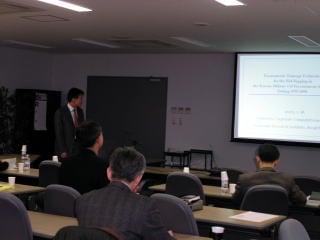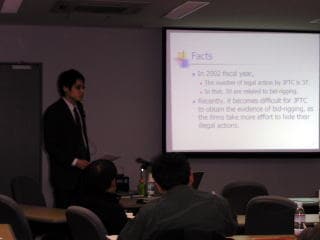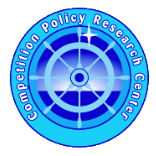Outline of Japan and Korea Mini Conference on Bid-rigging
Outline of Japan and Korea Mini Conference on Bid-rigging
January 25th 2005
Competition Policy Research Center (CPRC) held "Japan and Korea Mini Conference on Bid-rigging" on January 17th with the Graduate School of Economics, The University of Tokyo and with Seoul National University (Corporate Competitive Power Research Center).
1 DATE・PLACE
| DATE | Jan. 17th (Mon.) 2005 13:00-17:00 |
|---|---|
| PLACE | Meeting Room (6th floor), Faculty of Economics,University of Tokyo 7-3-1 Hongo, Bunkyo-ku, Tokyo |
2 OUTLINE OF THE PROGRAM
| ORGANIZERS | The Research Center for the Relationship between Market Economy and Non-market Institutions (CEMANO), a Center of Excellence (COE) program in the Graduate School of Economics, University of Tokyo The Center for Corporate Competitiveness at Seoul National University Center for International Research on the Japanese Economy (CIRJE) attached to the Graduate School of Economics, University of Tokyo Competition Policy Research Center (CPRC) |
|---|---|
| THEME | "Economics of Bid-rigging -- from examples in Japan and Korea --" |
| SESSION 1 | "Econometric Damage Estimation from the Bid Rigging in the Korean Military Oil Procurement Auctions during 1998-2000" Faculty of Economics,Seoul National UniversitySonku Kim, Keunkwan Ryu, Sang-seung Yi Korea Economic Research InstituteInkwon Lee |
| SESSION 2 | "An empirical analysis about Japanese 'Dango'" Noriyuki Yanagawa (Visiting Researcher of CPRC, Assistant Professor, Faculty of Economics, University of Tokyo, at Graduate School of Economics) Yuji Kimura (Guest Researcher of CPRC, Research Institute of Economy,Trade and Industry) Toshiko Suzuki (Researcher of CPRC) |
3 SUMMARY OF THE PROGRAM
(Responsibility for the contents: CPRC Secretarial Office)
We had a presentation themed "Econometric Damage Estimation from the Bid Rigging in the Korean Military Oil Procurement Auctions during 1998-2000" by Seoul National University.

This estimation was conducted by The Center for Corporate Competitiveness at Seoul National University (CCC) by using a method of quantitative economics regarding the damage of Korean National Defense Ministry suffered from the bid-rigging done by the five oil companies during 1998 - 2000. They reported that they could estimate net damages by adjusting difference of price depending on the time between the military-oriented market and the non-military market using "difference in difference method" which subtracts the difference between the military-oriented bidding price and non-military bidding price in the competitive situation from the difference between the bidding price of oil ordered by National Defense Ministry (military-oriented bidding price) and the bidding price ordered by organizations except for National Defense Ministry (non-military bidding price) in the bid-rigging situation.
This analysis also adopts two methods, OLS and WLS. There were some questions from participants concerning the value of using two methods,specifically the value of using WLS. As for those questions, they gave expalnation that they had adopted WLS as coping with the bias of estimation occured from mistakes of specification of models in this analysis and they said they hadn't used WLS for usual problems of uneven dispersion.
※ There were some parts in the contents of this HP which didn't explain the reports of the reporters of the conference during the time from Jan. 25 to 4th Feb. 2005. We apologize for the insufficient contents with the revision here.
On the other hand, the Japan side presented a progress report on the collaborative research of this year, "An empirical analysis about Japanese 'Dango'".Yuji Kimura, a guest researcher of our center gave this presentation and he answered questions and inquiries from participants with Noriyuki Yanagawa ( Assistant Professor, Faculty of Economics in the University of Tokyo at Graduate School of Economics).
Distributed material: Main parts(PDF:1,716KB) Slides(PDF:71KB)

This study compared and examined firms' bidding behaviors both in the collusive case and in the competitive case from the actual data of bid-rigging at the construction procurement auction conducted by three local government units in Japan by assuming that the situation before on-the-spot inspection is defined as the collusive case and after the inspection as the competitive case. Accordingly, in collusive cases firms tend to price the bid on the expense terms by setting utilization rate (the total amount of the prices of each firm accepted at the bidding divided by the highest price of the firm in the period of this analysis within three months of the bidding date) as the proxy variable. On the other hand, we cannot find such tendency in competitive cases. After the presentation there were questions from participants specifically from those of Seoul National University regarding the method to set utilization rate as the proxy variable of expense terms and the assumption that the situation after on-the-spot inspection of JFTC is defined as the competitive case.They explained that as for the expense terms, they adopted the data that they thought appropriate in the confines of limited data they were able to gain. As for the assumption of competitive situation, they explained that it might be inappropriate to think they have competed with each other from the first stage, however, the results of the analysis was consistent with their theoretical prediction.They also explained that they confirmed that those firms' quit the illegal behaviors after the on-the-spot inspection from the approval of JFTC and this is highly valued fact.
